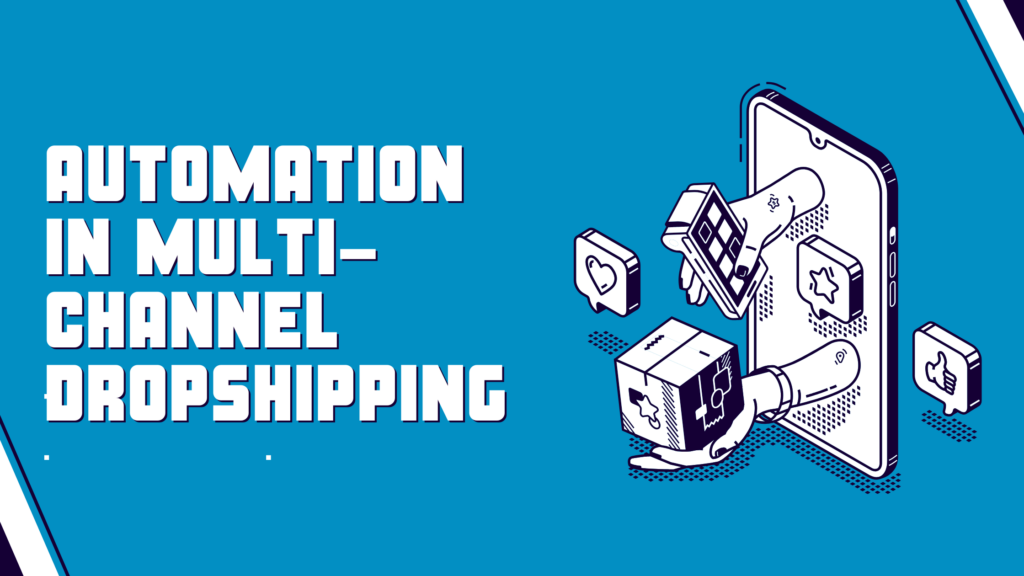The Role of Automation in Multi-Channel Dropshipping
Multi-channel dropshipping means selling products on multiple platforms like eBay, Shopify, Amazon, and so on. It allows businesses to reach more customers and increase sales. However, managing orders, inventory, and suppliers across several channels can become overwhelming. That’s where multi-channel dropshipping automation comes in. Automation simplifies and streamlines tasks like order routing, inventory syncing, and shipping processes. As ecommerce grows, automation is becoming essential to handle the increasing complexity and demand. It helps businesses save time, reduce errors, and improve efficiency, allowing them to scale operations without sacrificing control.
Understanding Multi-Channel Dropshipping
Multi-channel dropshipping refers to selling products across various online platforms, such as Amazon, eBay, Shopify, and other marketplaces while utilizing third-party suppliers to handle product fulfillment. This approach allows dropshippers to reach a broader audience by leveraging multiple sales channels instead of relying on a single platform. Multi-channel dropshipping automation is essential in this process, as it helps manage orders, inventory, and shipping across all platforms seamlessly. Key components of multi-channel dropshipping include managing product listings, tracking stock levels, automating order routing, and syncing inventory in real-time across different platforms. Automation tools, like Flxpoint, can simplify this process, ensuring that inventory updates and order fulfillment are managed efficiently without manual intervention.
Benefits and Challenges of Selling Across Multiple Platforms.
Using multi-channel dropshipping automation tools can help you overcome these challenges. Moreover, they streamline processes and improve efficiency.
Benefits
- Wider audience reach – By listing products on multiple platforms, you increase visibility and reach different customer bases.
- Diversified income streams – Selling on more than one platform minimizes the risk of over-reliance on a single source of revenue.
- Increased brand presence – Selling on popular marketplaces can boost your brand’s credibility and exposure.
- Optimization of sales performance – By tracking platform-specific performance, you can make data-driven decisions to improve sales.
Challenges
- Inventory management complexity – Managing stock levels across platforms without automation can lead to overselling or stockouts.
- Order fulfillment coordination – Coordinating order fulfillment across multiple suppliers for different platforms can be challenging.
- Platform policies and fees – Each platform has its own set of rules, fees, and requirements, which can be difficult to navigate.
- Customer service – Providing consistent service across platforms can be time-consuming without proper systems in place.
The Need for Automation in Dropshipping
As dropshipping businesses grow, managing manual operations becomes difficult. Scalability issues are common when handling orders across multiple sales channels. Manually processing orders, tracking inventory, and managing supplier communications can be overwhelming and lead to inefficiencies. When dealing with multi-channel dropshipping, the challenge becomes even bigger, as orders come in from various platforms like Shopify, Amazon, and eBay.
Time and resource constraints also add pressure. Manual operations consume valuable time that could be spent on growing the business. The need to check stock availability, process each order, and communicate with suppliers manually limits how fast you can scale. You need more resources, and hiring additional staff just to keep up is costly. This slows down your ability to expand into new markets and sales channels.
Additionally, automation helps reduce human errors, which are common in manual processes. Mistakes like sending incorrect orders, updating the wrong stock levels, or missing shipping deadlines harm your business. Customers expect timely delivery and accurate information, so even a small mistake can lead to negative reviews and loss of business. By implementing multi-channel dropshipping automation, you minimize these errors.
Automation can greatly improve efficiency by streamlining all these processes. It can automatically update inventory across all platforms, route orders to the correct supplier, and ensure timely shipment. This not only saves time but also ensures consistency across multiple channels. Automation tools can manage complex workflows with ease, allowing you to focus on other important aspects of your business.
Ultimately, multi-channel dropshipping automation solves the scalability issues of manual operations, removes time and resource constraints, and significantly reduces errors, leading to better customer experiences and smoother operations. It is essential for any dropshipping business looking to scale quickly and effectively.
Key Areas of Automation in Multi-Channel Dropshipping
Inventory Management
In multi-channel dropshipping automation, managing inventory effectively is critical. Real-time stock updates across all sales channels ensure that customers see accurate availability, reducing the risk of overselling. Automated inventory syncing helps keep stock levels consistent, no matter how many platforms you sell on.
Automated reordering systems can help you maintain optimal stock levels. These systems monitor inventory levels and automatically reorder from suppliers when stock runs low, preventing stockouts. By automating these processes, you can focus more on growing your business and less on manual inventory management tasks, improving overall efficiency.
Order Processing
Effective multi-channel dropshipping automation requires streamlined automated order routing and fulfillment. By automating this process, orders are directed to the most suitable supplier based on inventory availability, location, and delivery speed. This not only speeds up fulfillment but also reduces human error, ensuring faster and more accurate deliveries.
Additionally, integrating with multiple suppliers is vital for seamless inventory management. Automation allows you to monitor stock levels across all suppliers in real time, helping to avoid stockouts or overselling. It ensures that your inventory is always up-to-date, no matter how many channels or suppliers you’re managing. Efficient integration makes it easy to handle even complex multi-channel operations without manual intervention.
Pricing and Repricing
In multi-channel dropshipping automation, dynamic pricing strategies are essential to keep your prices competitive across various platforms. With dynamic pricing, you can automatically adjust your product prices in real-time based on market changes, demand, and competitor pricing. This ensures you remain competitive without manual intervention, saving time and effort.
Additionally, competitive price monitoring and adjustment tools help you track your competitors’ prices and adjust yours accordingly. By automating this process, you can respond quickly to pricing shifts, maximizing your profits while staying ahead of the competition. This automated approach ensures your pricing remains competitive across multiple sales channels.
Customer Service
Automation plays a key role in improving customer service in multi-channel dropshipping automation. Chatbots and automated responses help businesses respond quickly to customer inquiries. These tools provide instant answers to common questions, reducing the need for manual customer support. This ensures fast communication, even outside of business hours.
Centralized customer information management streamlines service by organizing customer data from multiple channels in one place. It allows businesses to track customer interactions, preferences, and order history across all platforms. This helps deliver personalized and efficient service, improving customer satisfaction. By integrating these automation tools, businesses can handle customer service more effectively while saving time and resources.
Marketing and Promotions
Automated email marketing campaigns allow you to send targeted messages based on customer behavior, preferences, and order history. These personalized emails can include product recommendations, abandoned cart reminders, or special promotions, helping to increase engagement and conversion rates without manual effort.
Cross-channel promotion synchronization ensures your marketing campaigns are consistent across all platforms, from social media to your ecommerce site. Automation tools help manage discounts, deals, and campaigns on multiple channels at once, keeping everything in sync. This saves time and ensures your promotions reach the widest audience possible, enhancing your brand visibility and sales across various platforms.
Benefits of Automation in Multi-Channel Dropshipping
Automation in multi-channel dropshipping offers significant advantages that can help your business grow while saving time and resources. By automating processes like inventory management, order fulfillment, and shipping across various sales channels, you can increase efficiency, improve customer satisfaction, scale operations smoothly, and make better data-driven decisions.
Increased Operational Efficiency
One of the main benefits of multi-channel dropshipping automation is the increased efficiency it brings to daily operations. Automating tasks like updating inventory levels, routing orders to suppliers, and managing returns helps you avoid time-consuming manual work. With automation, you can manage multiple sales platforms such as Amazon, eBay, and Shopify from one centralized system. This not only reduces human errors but also frees up your team to focus on more critical tasks like marketing and customer support. Overall, automation makes your business run smoother, cutting down on delays and reducing the risk of mistakes.
Improved Customer Satisfaction
Customer satisfaction is key to a successful dropshipping business, and multi-channel dropshipping automation plays a huge role in ensuring a positive customer experience. Automation ensures that orders are processed quickly, with accurate stock levels and real-time updates. When customers receive their products faster and with fewer errors, they are more likely to leave positive reviews and return for future purchases. Additionally, automated systems allow for better communication with customers by providing automated tracking updates and quicker responses to inquiries, further improving their experience.
Enhanced Scalability
As your dropshipping business grows, managing multiple channels and suppliers can become overwhelming. Multi-channel dropshipping automation makes it easier to scale your operations by handling increased volumes efficiently. Whether you’re expanding to new sales platforms or adding more products to your inventory, automation systems can manage the increased workload without needing more manual effort. This means you can grow your business without significantly increasing operational costs or resources. Automation helps you scale your dropshipping model seamlessly, allowing you to focus on growth strategies.
Better Data Analytics and Decision-Making
Automation also provides you with valuable data insights to improve decision-making. With multi-channel dropshipping automation, you have access to comprehensive reports on sales, inventory levels, and customer behavior across all platforms. This data allows you to make more informed decisions, such as adjusting pricing strategies, optimizing inventory levels, and identifying new market opportunities. By leveraging automation for data analytics, you can fine-tune your business strategies and stay ahead of the competition.
Challenges and Considerations
Implementing multi-channel dropshipping automation can bring significant benefits, but there are challenges and considerations to keep in mind.
Initial Setup Costs and Complexity
The first hurdle many businesses face is the initial setup costs. Investing in the right automation tools requires a financial commitment, especially if you’re integrating multiple platforms and sales channels. Besides cost, the complexity of setup can be daunting. You need to link different systems like your suppliers, order management, and shipping services to work seamlessly across multiple channels. This process can involve technical expertise and time to ensure everything is functioning correctly. It’s essential to budget not just for the software but for the potential need for outside help, whether it’s hiring a consultant or using a tech support team to ensure proper integration.
Choosing the Right Automation Tools
With so many options for multi-channel dropshipping automation tools, choosing the right ones can be overwhelming. Each platform comes with unique features, integrations, and pricing structures. The goal is to find automation software that suits your specific needs. For example, if you’re selling across Shopify, eBay, and Amazon, you’ll want tools that can synchronize your inventory, route orders efficiently, and streamline shipping. Some tools are excellent at automating order routing, while others excel at handling customer communication. It’s important to evaluate the functionality that will offer the most value for your business. Flxpoint, for example, offers robust solutions for automating inventory syncing and managing multi-channel fulfillment, making it a valuable tool for dropshippers scaling across different platforms.
Maintaining a Personal Touch in Customer Interactions
Automation can make your operations more efficient, but maintaining a personal touch in customer interactions is crucial. When everything becomes automated, there’s a risk of making your business feel too mechanical and disconnected from customers. Customers value personalized experiences and human touchpoints, especially when it comes to customer service. Automated responses are useful for initial queries, but you should still incorporate opportunities for real-time human interaction when necessary. Ensure that while multi-channel dropshipping automation is helping you scale, you still maintain direct communication with customers when needed. Personalized follow-ups, customer support, and handling of special requests should remain a priority to enhance customer loyalty and satisfaction.
Future Trends in Dropshipping Automation
The future of multi-channel dropshipping automation is exciting and filled with innovative technologies. As ecommerce continues to grow, automation will play an even more critical role in helping businesses streamline operations and enhance customer experiences. Here are some key trends shaping the future of dropshipping automation.
AI and Machine Learning Integration
Artificial Intelligence (AI) and machine learning are becoming essential tools in dropshipping. These technologies can analyze large volumes of data to identify patterns and trends. By integrating AI into dropshipping operations, businesses can automate tasks like customer service, inventory management, and order processing. Chatbots can handle customer inquiries, freeing up human agents for more complex issues. Additionally, AI can optimize pricing strategies by analyzing competitor prices and customer behavior, ensuring you remain competitive.
Predictive Analytics for Inventory and Demand Forecasting
Predictive analytics will revolutionize how businesses manage inventory. By using historical data and trends, businesses can forecast demand more accurately. This means that they can stock the right products at the right time, reducing the risk of stockouts or overstocking. Automated systems will analyze factors like seasonality, market trends, and sales patterns to recommend optimal inventory levels. This approach leads to better decision-making, improved cash flow, and enhanced customer satisfaction by ensuring products are always available.
Enhanced Cross-Platform Integration
As dropshippers expand into multiple sales channels, the need for seamless cross-platform integration becomes crucial. Future dropshipping automation will focus on enhancing integrations across various e-commerce platforms, such as Shopify, Amazon, and eBay. This will allow businesses to synchronize inventory, orders, and customer data in real time. With a unified view of all operations, businesses can respond quickly to market changes and customer demands. This integration will also simplify the management of different sales channels, reducing the complexity of multi-channel selling.
Conclusion
Automation plays a vital role in multi-channel dropshipping. It streamlines processes, reduces errors, and saves time, allowing businesses to operate more efficiently across various platforms. By automating tasks like order processing, inventory management, and customer communication, you can focus on growing your business and enhancing the customer experience. However, while automation is beneficial, it’s essential to balance it with human oversight. Automated systems can handle routine tasks, but human judgment is crucial for addressing unique challenges and ensuring quality service. A combination of multi-channel dropshipping automation and personal touch will lead to better decision-making and stronger customer relationships. Embrace automation, but don’t forget the importance of human interaction in building trust and success in your dropshipping venture.



